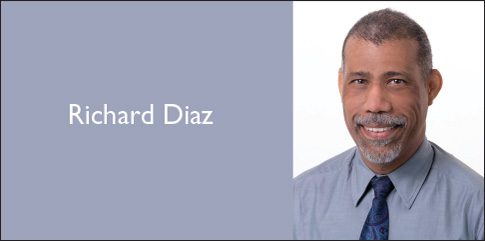Faculty Info
Name: Richard Diaz
Department: Department of Education
“I was aware of the growing education gap and knew I had to do something meaningful”
– Richard Diaz
Past Profiles

Navigating Between Cultures to Empower New Teachers
Richard Diaz, the son of Afro-Cuban immigrants, knows what it means to “code switch”—to communicate effectively to people of many ethnicities by understanding and tapping into their cultural DNA. “I’ve had to do this all my life,” says Diaz, “and so do most young people.” Diaz brings his skill in intercultural communication to students from many backgrounds enrolled in the Teacher Opportunity Corps (TOC). This program, which has a strong mentoring component, is intended to diversify the teaching force. “These students often face economic challenges,” he says. The state-funded TOC gives them a stipend for participating in a 200-hour internship in a high-needs school—typically in South Queens–before they student-teach in that same school. “At that point, they’ve been groomed and are familiar with the scene,” Diaz says.
Recently, Diaz has recruited candidates with undergraduate degrees for the Urban Teacher Residency, an initiative launched in summer 2018 that attracts career-changers. An unusual feature is that accepted students earn a salary from the Department of Education while they complete their teaching courses and credentialing. “Because they don’t have to hold outside jobs, they can focus full time on their education and professional development,” says Diaz. When hired as teachers, they are carefully paired with an experienced colleague.
A goal of both programs, Diaz points out, is to cultivate teachers from groups underrepresented in teaching who won’t simply go to work and leave the community behind at the end of the day, like tourists leaving a foreign country. “We want to prepare people to be change agents and empower their students to be masters of their own lives,” he says “Richard caught my eye with his problem-solving acumen and mediational skills when he was a master’s student here,” says Eleanor Armour-Thomas, chair of Secondary Education and Youth Services. “Since then I have come to know him as an adjunct faculty member and director of education programs. He is a generous, humane, creative, and enterprising person who always goes the extra mile for the team.” Diaz’s unusual, varied background makes him uniquely qualified for his work.
A self-described “poor kid from the Bronx projects,” he later moved with his sister and mother, a seamstress, to Elmhurst. Although enrolled at Newtown High School, he took all of his classes at The Mount Sinai Hospital with a small cohort of high-achievers selected from across the city. After the school day, he stayed at the hospital for internships. Planning to become a doctor, Diaz majored in biology at City College while earning a minor in the visual arts, a field he has long embraced. “As an undergrad, I was fortunate that the sculptor Seymour Lipton took me on as his apprentice,” he says.
But when Diaz was accepted to medical school, he turned it down. “I didn’t want to go into debt and walk away from helping to support my family,” he recalls. Instead, he embarked on a career in advertising with prominent agencies such as Ogilvy & Mather and Young & Rubicam, developing strategic media investment plans for their clients.
Over several years, he worked for agencies that specialized in media planning for the Hispanic market. “I shared my insights about cultural distinctions that go beyond language to help them make meaningful and lasting connections to consumers,” Diaz says.
The advertising work was demanding, lucrative and “individually fruitful,” he says—but promoting consumerism and generating revenue for billion-dollar corporations led to a feeling of dissonance that he couldn’t ignore. “I was aware of the growing education gap and knew I had to do something meaningful,” he says. The new career? Teaching art, which Diaz calls “an effective point of entry to help others engage in discovery and make connections to virtually everything. The visual is everyone’s first language.”
While earning his MS in art education, Diaz took advantage of Study Abroad, traveling to Jingdezhen, known as China’s porcelain capital, and learning some Mandarin. He also taught art at a girls’ vocational school in India founded by a visionary who, after retiring from a successful business career, built the school to empower those who faced great inequities. “From these experiences, I learned the Platinum Rule: ‘Do unto others as they would do unto themselves.’ It’s about understanding others’ cultures and having empathy,” Diaz says.
After graduation, he taught art in grades K though 12, mainly at public schools in the Brooklyn neighborhoods of Crown Heights, Park Slope, and Bushwick. In his role as an adjunct professor at QC, Diaz teaches education methods courses to pre-service and new art teachers.
“Art is a catalyst that can bring people together, a means of expression that provides endless ways for individuals to share what matters to them regardless of their technical abilities,” he says. “I’ll always be compelled to make art,” adds Diaz, who can draw, sculpt, weld, and create ceramics.
“Making art is less about the time needed to complete works,” he continues. “It’s more about having occasions to function holistically as a fully integrated way of being. In some ways, my work at Queens College has become part of my art.”

